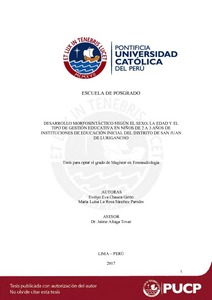| dc.contributor.advisor | Aliaga Tovar, Jaime Ramiro | |
| dc.contributor.author | Chauca Girón, Evelyn Eva | es_ES |
| dc.contributor.author | La Rosa Sánchez Paredes, María Luisa | es_ES |
| dc.date.accessioned | 2017-08-29T17:44:22Z | es_ES |
| dc.date.available | 2017-08-29T17:44:22Z | es_ES |
| dc.date.created | 2017 | es_ES |
| dc.date.issued | 2017-08-29 | es_ES |
| dc.identifier.uri | http://hdl.handle.net/20.500.12404/9252 | |
| dc.description.abstract | Do you know if the morphosyntactic development is the same in children of
different gender, age and school or differs according to these? In the process of
language acquisition, there are a number of uncertainties that psycholinguistics,
linguistics, psychology and education seek to clarify, in order to improve our
knowledge about this situation. Therefore, this thesis tries to describe the
morphosyntactic development of children from 2 to 3 years of age and their
differences according to sex, age and type of educational management in the district
of San Juan de Lurigancho, Lima - Peru. Next, the process, the results and the
conclusion of the present investigation will be presented.
For this, the Average Length of Morphea Statement (LME) was used as a
measurement instrument, since it is an indicator of the morphosyntactic
development of a child. In addition, a new proposal of morphosyntactic analysis is
presented.
In this sense, it was possible to reach the proposed objectives of checking,
determining, describing, analyzing and comparing the morphosyntactic
development of competent children of the Spanish language. Since the morphemes
used in the sample were quantified, which were collected in different spontaneous
situations. Likewise, the frequency of use of these morphemes was verified
according to sex, age and type of educational management. And the descriptive -
correlational method was used.
The results will serve to identify linguistic alterations in morphosyntactic
development and from this, to propose, in the future, work strategies to improve the
performance of children from 2 to 3 years. Also, a morphosyntactic development
pattern will be available to guide the planning of future interventions.
Finally, we conclude that there are significant differences in
morphosyntactic development according to age and type of schooling, but not with
respect to sex. | es_ES |
| dc.language.iso | spa | es_ES |
| dc.publisher | Pontificia Universidad Católica del Perú | es_ES |
| dc.rights | info:eu-repo/semantics/openAccess | es_ES |
| dc.rights.uri | http://creativecommons.org/licenses/by-nc-nd/2.5/pe/ | * |
| dc.subject | Niños--Lenguaje | es_ES |
| dc.subject | Adquisición del lenguaje | es_ES |
| dc.title | Desarrollo morfosintáctico según el sexo, la edad y el tipo de gestión educativa en niños de 2 a 3 años de instituciones de educación inicial del distrito de San Juan de Lurigancho | es_ES |
| dc.type | info:eu-repo/semantics/masterThesis | es_ES |
| thesis.degree.name | Maestro en Fonoaudiología | es_ES |
| thesis.degree.level | Maestría | es_ES |
| thesis.degree.grantor | Pontificia Universidad Católica del Perú. Escuela de Posgrado | es_ES |
| thesis.degree.discipline | Fonoaudiología | es_ES |
| renati.discipline | 916117 | es_ES |
| renati.level | https://purl.org/pe-repo/renati/level#maestro | es_ES |
| renati.type | http://purl.org/pe-repo/renati/type#tesis | es_ES |
| dc.publisher.country | PE | es_ES |
| dc.subject.ocde | https://purl.org/pe-repo/ocde/ford#3.05.03 | es_ES |






